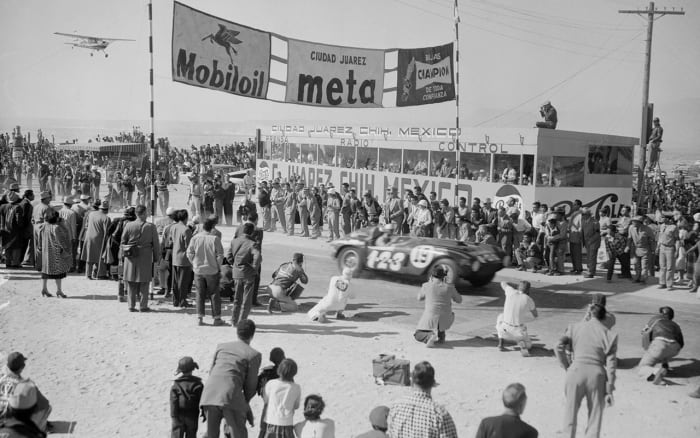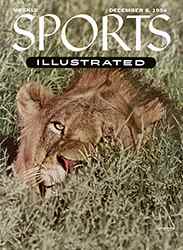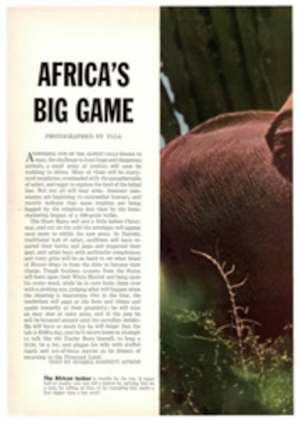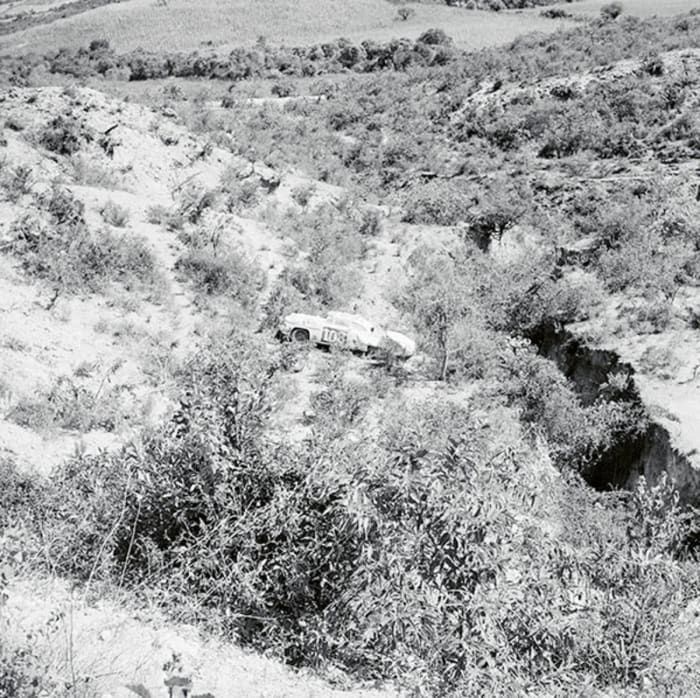New king of the mountains
JUÁREZ, MEXICO — This year again, on the eve of the fifth Pan American Road Race, the jungle town of TuxtlaGutiérrez in southern Mexico was alive with alien noise. Drivers and mechanics babbling in six tongues swarmed the streets, readying their cars. Engines coughed and snarled through the night, and at dawn on the paved highway through town 149 cars stood ready. At 6 a.m. the starting flag swung down, sending the first car in line, a squat, red Ferrari, on its way. Then once each minute the flag dipped, and another and another of the cars sped away, north to the mountains in the toughest, most dangerous race in the world.
From Tuxtla Gutiérrez the course ran along the jagged mountain spine of Mexico—a tortuous route of blind curves, S-curves, hairpin turns and sudden roller-coaster dips, up and down mountains, on to flat straightaways almost at sea level, then up again 10,000 feet in the mountains, and finally across the rolling north Mexican plateaus to Juàrez on the U.S. border. In the treacherous first half of this 1,908-mile race there are more than 3,000 curves where a driver can miscalculate, corner with too much drift or lose the feel of the road, and go to his death down the mountain. As the cars sweep by, the people of the mountain towns line the road. The cautious ones stand on the straightaways and see little. The bold ones want to see it all, so they crowd the dangerous curves and pray to the Virgin of Guadalupe.
After three drivers and six spectators were killed last year, the great Italian road racer Giovanni Bracco concluded bitterly, "This race will kill us all. The Italians will not race in Mexico again." But fear kept no one away. This year the gloomy Bracco himself was racing again among the 20 drivers from six countries in the fast, large sports car class. For the past two years the honors in the Pan American had been won by expensive team efforts, a Mercedes team taking first and second in 1952, and a Lancia team first, second, and third in 1953. With the 1953 champion, Fangio, not defending, outwardly the race seemed wide open this year, but actually it was the field against one man, 26-year-old Umberto Maglioli of Biella, Italy, who not only is surprisingly young to be a prerace favorite in such a smart field but also surprisingly solemn for a good-looking Italian. "Maglioli is something different," an Italian friend shrugs. "He is not wild. He does not eat much; he drinks less than he eats. He is not crazy over women. The head rules him. For a young Italian that is odd. For an Italian race driver it is nearly impossible." Though away from the cars he dresses and behaves more like the doctor his doctor father wanted him to be, after two years racing the big sports cars, Maglioli (pronounced Moll-yó-lee) ranked eighth in the world. In 1952 he placed fourth in the Pan-American and last year sixth, setting new records for the straight laps through the north country. As they swept out of Tuxtla Gutiérrez this year, every rival knew that to win he must beat Maglioli in the mountains. Mounting a large, new 4.9-liter Ferrari, once out of the mountains, Maglioli could eat through the stretches at 170 miles an hour. For the first two days an American, Phil Hill, in a lighter, more nimble Ferrari, stayed 39 seconds ahead of Maglioli. But as the flag waved him off on the third day, Maglioli's jaw was set. Though still in the mountains he swept by Hill. He had only to hold his luck through the rolling foothills and he would be the new king of the Mexican mountains.
Among the other 129 cars in this year's grueling five-day race to Juàrez—the Lincolns, Buicks, Cadillacs, Packards and Oldsmobiles in the large stock car class; the Fords, Dodges, Chevrolets and others in the small stock class; the Porsches, Oscas and Borgwards in the small sport class; the Alfa Romeos and Volkswagens in the special European stock class—there were a few two-car teams, but most were running, like the large sports cars, car against car for a share of the total $117,000 prize money. Only the Lincolns, out to repeat triumphs in 1952 and 1953, were organized on a grand scale. Following the Lincolns was a trailer retinue to service their seven-car team. For drivers, Lincoln had the best: Chuck Stevenson, who had won the Pan-American for them in 1952 and 1953; Indianapolis winner Bill Vukovich; Indianapolis drivers Jack McGrath, Johnny Mantz and Walt Faulkner; Mexican driver Fernando Murphy, and the Pasadena millionaire, Ray Crawford. But this year in the rough and dangerous mountains, even the safety of numbers was barely enough to clinch it for the Lincolns.
The Lincoln crew set up its first advance base 217 winding miles north of the start. Exactly two hours after the first red Ferrari has been waved off in Tuxtla Gutiérrez, the Lincoln short wave radio from an outpost down the road comes alive: "LM Five to LM One...here comes the first car...a red job...." This would be the first car off, the 4.9-liter Ferrari driven by Jack McAfee and Ford Robinson, one of the three cars with a good chance to beat Maglioli in the mountains. Within 15 minutes McAfee should be coming by the Lincoln advance base.
McAfee never comes. Going 120 miles an hour into a deceptive right curve, McAfee's Ferrari broadsides across the road, rolls over twice down a 30-foot bank, mowing down the brush for 300 yards. McAfee is shaken up. Ford Robinson is dead. "No blood," a spectator observes. "A clean break of the neck."
IN A HAIR-RAISING DRIFT
"Two more sports cars," the radio crackles. Through the curve sweeps a blue and white Ferrari, howling past in a hair-raising drift, 90 miles an hour. It is U.S. driver Phil Hill, incredibly in first place so soon, though he started almost last among the large sports cars. And hard behind him—barely three seconds—comes Maglioli. Bracco, the wild mountain driver and the only one other than Hill and McAfee who has a sound chance to beat Maglioli in the mountains, should be close behind, since he started before both Hill and Maglioli. But Bracco's Ferrari is one of nine cars already either completely out or limping badly from the grind of the first morning. The Lincolns of Mantz, Murphy and Stevenson are, like Bracco, already out of contention.
Lincoln driver McGrath also goes out on this leg. On a curve, he skids from the road, down an incline, but is able to walk away from it, leaving his car almost completely buried in the jungle brush.
Of the seven-car Lincoln team, that leaves only Vukovich, Faulkner and Crawford. Faulkner leads the remaining three Lincolns into the pit stop. The rules forbid assistance with a tire change during a lap. Faulkner and Co-driver Frank Hainley change the four tires in three and a half minutes. Four minutes later Vukovich pulls up. His language explodes in a fury as a lug wrench fouls, but he changes his four tires in two and a half minutes and is away. As Crawford, the last of the Lincolns, pulls up, Mickey Thompson in a Ford sweeps by, leading the small stock cars—he is safely through the grim curve in the plains of Tehuantepec where last year he plowed through straying spectators, killing six and nearly himself. In fierce rivalry, the small stocks roar by, screeching, skidding, in twos and threes, almost bumper to bumper, and among them the Italian, Sanesi, in an Alfa Romeo, leading the small European stock cars. And for an hour more come stragglers who have lost their courage or luck.
At the first overnight stop at Oaxaca, 127 of the 149 cars are still running. After a record-breaking run, Hill leads Maglioli by four minutes, nine seconds. "Don't clobber the hay bales at Atlixco and ruin your chance," a friend warns. Hill gets through Atlixco, but on sidewalk and balcony around the town square, where the route takes a 90-degree right turn and immediately a 90-degree left, the people of Atlixco have a gay day as car after car skids and broadsides into the hay bales. "Carro a la vista, se√±ores!" (A car in sight, gentlemen) the public-address system bleats out. With a thunderous growl, Maglioli's Ferrari streaks down the narrow streets. There is the "Errshoommm" sound of a deft downshift, and—a minute and nine seconds behind Hill in elapsed time—Maglioli slips easily through the tricky turns.
A WILD SLIDE IN THE BALES
The crowd shrieks delightedly at Maglioli's finesse, but the hot race of the smaller sports cars gives them a greater thrill. It is close between Germans Karl Bechem and Franz Hammenich in Borgwards, the Argentine Roberto Mieres in an Osca, the Guatemalan Jaroslav Juhan in a Porsche and his teammate Hans Hermann in a Porsche. Racing eagerly to catch a Porsche a scant second ahead, the Argentine in the Osca misses the turn in Atlixco, slides wildly into the curve, scattering the bales like shredded wheat. He is wrecked and out of it. Soldiers drag sandbags to reinforce the hay bales, and for an afternoon the small stock cars keep the show going, slamming and spinning into the hay. Faulkner's Lincoln and Crawford's have gone through successfully, but Vukovich is overdue.
Vukovich is out, and lucky to be out with his life. Seven miles south of Petlalcingo, he breasted a hill 100 miles an hour, coming suddenly into a blind right turn. Helpless as the Lincoln skidded across the road on two wheels, he plunged over the side of a 150-foot ravine, turning over five times.
Before the first cars reach Mexico City, down roads lined with hundreds of thousands, the small sports car class has been cut to a three-way race. Outside Puebla, Borgward driver Hammenich hits a dog and crashes off the road.
Into Mexico City, Hill still shows the way to Maglioli, and it is a close squeak for Maglioli as he tries to close on the front-running Hill, averaging 94 miles an hour. A tire blows; Maglioli's Ferrari swerves, starts to slide, then holds the road. One hundred and eleven cars make it under power to Mexico City. The 112th, a Buick driven by Fernando Maciel, breaks down two miles from the finish in the noisy defile of spectators. Since they are running ahead of the time limit, to the cheers of the crowd Maciel and Codriver Sergio Campo push their car the last two miles, then faint from exhaustion.
Toward the end of the next day's run, a total of 590 miles north from Mexico City, the race will be coming out of the mountains. Maglioli might well wait for the last two-days' run on the plateaus, but he does not. He overtakes Hill in the mountains. Realizing he has lost on the winding roads where he had his only real chance, Hill lets Maglioli go and settles for a safe second. This last mountain stretch, up and down and along the sides of the western Sierra Madre range, takes a heavy toll on the rest of the field.
The three-way rivalry in the small sports class suddenly becomes an intra-team race between the Porsches. German Karl Bechem, leading both Porsches in his Borgward and third in the over-all race, spins out on a curve at Rio Hondito. While soldiers are recovering injured Bechem, Joaquin Palacios of the Dominican Republic, driving the $29,000 special Pegaso for Dominican President Trujillo, misses the same turn. On the first flip, Palacios is thrown clear, but his car crashes on, felling one of the soldiers. Within an hour U.S. driver Frank Davis misses the same turn, plows into the same field as Bechem and Palacios, but walks away.
Chilean Patricio Achurras loses control just south of Aguascalientes, kills two spectators, injures another and fractures his own skull. And on the next day, north of Durango, the Mexican co-driver Leopoldo Olvera crashes in his Dodge and is killed.
For the fourth day's run, 437 miles from Durango to Chihuahua, there are only 95 cars and here, for Maglioli's big Ferrari, the road straightens out. He has a six-minute lead on Hill, and he runs for Chihuahua as if the whole race pack were a car length behind. For the first leg to Parral he averages 112 miles an hour, breaking his own 1953 record. From Parral to Chihuahua he again breaks his own record, hitting over 160 on the long straightaways, and averaging 130 miles an hour. Hill is a well-beaten second, 25 minutes behind, his rear-axle assembly working loose, valve timing off, a magneto out of kilter after the blistering run. Then, for the last short run to the finish at Juàrez, Maglioli backs away, playing it safe, knowing that he has it so long as he keeps Hill behind him.
A ROARING ESCORT
At dawn of the final day, outside Juarez, aficionados bivouac to be sure not to miss the run for home. By mid-morning there are 100,000 crowding the finish at the Mexican Aeronaves Airport. Private planes pick out the red of Maglioli's Ferrari, trailed by Hill's blue and white. As Maglioli comes into the finish 134 miles an hour, 50 feet overhead a roaring escort of planes sweeps across the line with him.
He has come 1,908 miles at an average of 107.9 miles an hour, beating World Champion Fangio's 1953 time by 30 minutes. The Porsche team of Hermann and Juhan sweep across the line not a length apart, both averaging over 97 miles an hour for a small sports car record by more than four hours. Though their five teammates had been forced out, Crawford and Faulkner take first and second in the large stock class, to give Lincoln its third straight win. In the small stock class, Dodges win the first four places, and in the special European stock class, Alfa Romeos win the first five.
Eighty-seven of the 149 cars finish. Six in all—four drivers and two spectators—have been killed. Over 25 drivers left the wrecks of their cars back in the mountains. It is a costly racing game even for a winner such as Maglioli. From his $18,000 prize, only $5,000 will be left after expenses. However much it costs, most of the great ones will be back to try again. "Road racers are like roulette players," Maglioli, the new king of the mountains, explains it. "We who race know that it is dangerous, but once we get the fever, we are satisfied with nothing else."
[originallink:10457751:40886]



